75-foot class inland construction tender
- USCGC Anvil (WLIC-75301)
- USCGC Axe (WLIC-75310)
- USCGC Clamp (WLIC-75306)
- USCGC Hammer (WLIC-75302)
- USCGC Hatchet (WLIC-75309)
- USCGC Mallet (WLIC-75304)
- USCGC Sledge (WLIC-75303)
- USCGC Vise (WLIC-75305)
An inland construction tender is a type of ship used to build and service shore structures such as piers and buoy trestles. It is also used to maintain buoys and aids to navigation. [1] Less frequently, they may be used for law enforcement, environmental, icebreaking, and search and rescue operations. [2]
The United States Coast Guard currently has three classes of inland construction tenders designated as WLIC. [3]
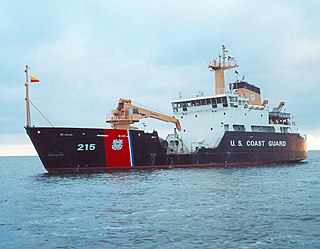
USCGC Sequoia (WLB-215) is a United States Coast Guard 225-foot Seagoing Buoy Tender, homeported in Apra Harbor, Naval Base, a deep-water port on the western side of the United States territory of Guam.

The USCG seagoing buoy tender is a type of United States Coast Guard Cutter used to service aids to navigation throughout the waters of the United States and wherever American shipping interests require. The U.S. Coast Guard has maintained a fleet of seagoing buoy tenders dating back to its origins in the U.S. Lighthouse Service (USLHS). These ships originally were designated with the hull classification symbol WAGL, but in 1965 the designation was changed to WLB, which is still used today.

The Keeper class of coastal buoy tenders consists of fourteen ships built for and operated by the United States Coast Guard. The ships were launched between 1995 and 1999 and all remain in active service. Their primary mission is to maintain thousands of aids to navigation, both buoys and land-based. Their secondary missions include marine environmental protection, search and rescue, law enforcement, and light ice-breaking.

USCGC Spar (WLB-206) is a United States Coast Guard Juniper-class seagoing buoy tender home-ported in Duluth, Minnesota. The ship maintains aids to navigation in the Twin Ports and Great Lakes.

Sassafras is a C-Class, 180 ft, seagoing buoy tender constructed for the USCG by Marine Iron & Shipbuilding Corp. of Duluth, Minnesota. Sassafras was one of 39 tenders commissioned for duties that would include aids-to-navigation, ice breaking, search-and-rescue, fire fighting, law enforcement, providing fuel and potable water, and assistance to the National Oceanographic and Seismographic Survey.

United States Coast Guard Cutter is the term used by the U.S. Coast Guard for its commissioned vessels. They are 65 feet (19.8 m) or greater in length and have a permanently assigned crew with accommodations aboard. They carry the ship prefix USCGC.
There are two classes of USCG Inland Buoy Tenders.
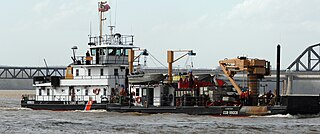
A buoy tender is a type of vessel used to maintain and replace navigational buoys. This term can also apply to an actual person who does this work.
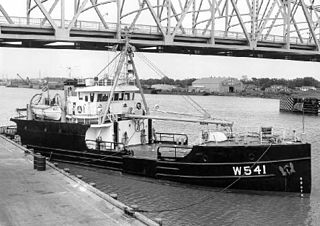
The USCGC White Alder (WLM/WAGL-541) was the former Navy lighter, YF-417. The United States Coast Guard acquired a total of eight of these former Navy YF-257-class lighters between 1947-1948 for conversion to coastal buoy tenders. They were needed to complement the larger seagoing buoy tenders in servicing short-range-aids-to-navigation, typically those placed in coastal waters and harbors.
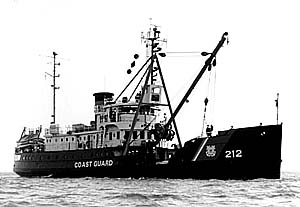
The United States Coast Guard Cutter Fir was the last lighthouse tender built specifically for the United States Lighthouse Service to resupply lighthouses and lightships, and to service buoys. Fir was built by the Moore Drydock Company in Oakland, California in 1939. On 22 March 1939, the U.S. Lighthouse Tender Fir was launched. She was steam driven with twin screws, 175 feet (53 m) in length, had a beam of 32 feet (9.8 m), drew 11 feet 3 inches (3.43 m) of water, and displaced 885 tons. Fir was fitted with a reinforced bow and stern, and an ice-belt at her water-line for icebreaking. She was built with classic lines and her spaces were lavishly appointed with mahogany, teak, and brass. The crew did intricate ropework throughout the ship. The cost to build Fir was approximately US$390,000. Fir's homeport was Seattle, Washington for all but one of her fifty one years of service when she was temporarily assigned to Long Beach, California when USCGC Walnut was decommissioned on 1 July 1982.

USCGC Elm (WLB-204) is a U.S. Coast Guard Juniper-class seagoing buoy tender home-ported in Astoria, Oregon. She is responsible for maintaining aids to navigation on the coasts of Oregon and Washington, including the Columbia River.

USCGC Cypress (WLB-210) is a United States Coast Guard cutter and the tenth Juniper-class seagoing buoy tender. She is outfitted with advanced technological and navigational capabilities that allow her to be positioned correctly for exact placement of buoys through the use of controllable-pitch propellers and stern and bow thrusters.

The USCGC Willow (WLB-202) is a United States Coast Guard seagoing buoy tender, the third of her name and the second of the Juniper-class. She is home-ported in Charleston, South Carolina, where she replaced her sister ship USCGC Oak in servicing 257 aids to navigation in District 7. Willow's area of operations stretches from South Carolina down to Caribbean, including Puerto Rico, Cuba, U.S. Virgin Islands and Haiti. In addition to her primary aids-to-navigation (ATON) role, Willow also performs other duties, such as maritime border security, marine environmental protection, maritime law enforcement, and search and rescue. The Willow transitioned from her former home port of Newport, RI in 2017 after spending over a year in a Baltimore dry dock being refitted and modernized.

USCGC Smilax (WAGL/WLIC-315) is a 100-foot (30 m) United States Coast Guard Cosmos-class inland construction tender. Commissioned in 1944, Smilax is the "Queen of the Fleet", the oldest commissioned U.S. Coast Guard cutter.

USCGC Kukui (WLB-203) is the third cutter in the Juniper-class 225 ft (69 m) of seagoing buoy tenders and is the third ship to bear the name. She is under the operational control of the Commander of the Seventeenth Coast Guard District and is home-ported in Sitka, Alaska. Her primary area of responsibility is the inland and coastal waters of southeastern Alaska. Kukui conducts heavy lift aids-to-navigation operations, and law enforcement, homeland security, environmental pollution response, and search and rescue as directed.
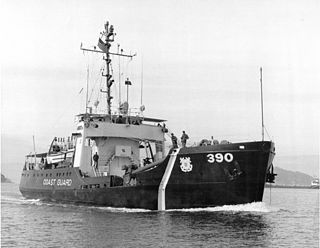
The USCGC Blackhaw (WLB-390) was a Iris-class buoy tender belonging to the United States Coast Guard launched on 18 June 1943 and commissioned on 17 February 1944.
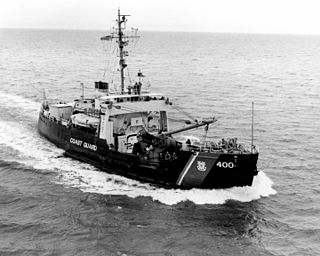
USCGC Salvia (WLB-400) was a United States Coast Guard Iris-class buoy tender in commission from 1944 to 1991. She operated in the Great Lakes and along the United States Gulf Coast during her career. Sold and renamed Brian Davis in 2020 for use as a memorial vessel, she was scuttled as an artificial reef in 2020.

USCGC Bluebell (WLI-313) is a United States Coast Guard inland buoy tender based out of Portland, Oregon.

Coast Guard Base Ketchikan is a major shore installation of the United States Coast Guard located in Ketchikan, Alaska. The base is a homeport for two Sentinel-class cutters and a buoy tender, and is the only Coast Guard dry dock in the state. Located one mile south of the city's downtown area along the southwestern shore of Revillagigedo Island, the base was originally established in 1920 to support the United States Lighthouse Service and became part of the Coast Guard in 1940. In addition to the homeported cutters, Base Ketchikan's maintenance facilities support forward-deployed cutters throughout Southeast Alaska, in Petersburg, Juneau and Sitka.